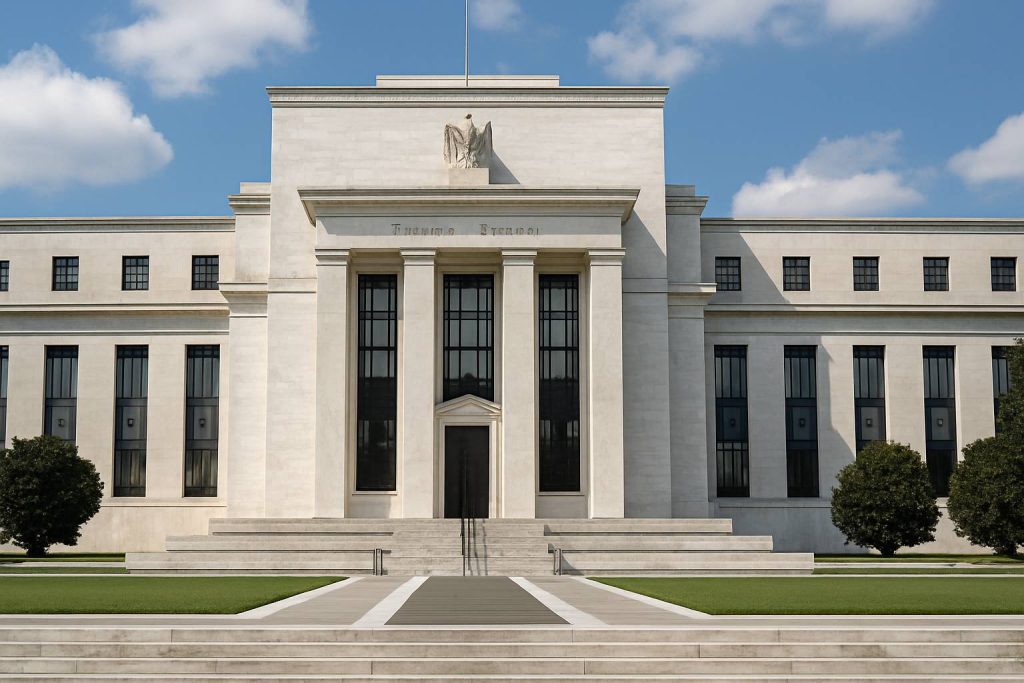How Federal Reserve Policy Could Reshape Investment Strategies in 2025
On Friday, August 22nd, Federal Reserve Chairman Jerome Powell delivered his latest highly anticipated speech at Jackson Hole, signaling that conditions may warrant interest rate cuts as the Fed proceeds carefully amid evolving economic conditions. This pivotal announcement sent markets soaring and marked a fundamental shift in monetary policy that sophisticated investors had been positioning for throughout 2025. Powell’s speech validated exactly what forward-thinking portfolio managers understood: diversification beyond rate-sensitive traditional assets through tangible investments that offered stability independent of Federal Reserve policy cycles and monetary uncertainty.
The Dow Jones Industrial Average showed a gain of more than 600 points following the public release of Powell’s speech while the policy-sensitive 2-year Treasury note saw a 0.08 percentage point fall. The job market concerns that prompted Powell’s dovish shift demonstrated how economic conditions could rapidly influence Fed policy decisions. This historic policy pivot reinforced why institutional investors had already been allocating capital toward alternative assets that offered performance uncorrelated with interest rate cycles and provided diversification benefits that conventional bond and equity portfolios could not achieve during monetary policy transitions.
The meeting summary depicted a divergence of opinion among the central bankers, whose vote to hold their key rate steady came despite objections from two Fed governors who argued in favor of cutting. Powell’s speech directed attention toward reexamining traditional portfolio construction, clearing the way for investment strategies that had previously been overlooked by ordinary investors focused on rate-dependent assets. Smart institutional investors recognized this policy shift as validation of strategies they had already implemented, allocating toward tangible assets that maintained value independent of Federal Reserve decisions and monetary policy fluctuations.
This Article Covers:
- The immediate market impact of Powell’s Jackson Hole rate cut signals
- Why alternative asset allocation became essential before Fed policy shifts
- How interest rate sensitivity drove institutional capital toward collectibles
- Why collector car investments offered superior portfolio protection during rate cycles
- How MCQ Markets provided early access to automotive assets insulated from Fed policy
Fed Rate Cut Revolution: Market Impact Analysis and Investment Opportunity Assessment
The policy signal represented recognition that traditional rate-sensitive allocations had failed to provide adequate portfolio stability during periods of monetary uncertainty and economic transition.
Fed Chair Jerome Powell gave the strongest indication yet that the central bank will cut interest rates as soon as September, with market participants assigning an 88% probability of a Fed cut following his speech. This monetary policy shift demonstrated how rapidly changing economic conditions could unlock massive capital flows toward investments that had previously been available only to sophisticated portfolio managers seeking rate-independent returns.
Powell’s speech addressed fundamental portfolio construction challenges that investors had faced throughout the current rate cycle. Traditional investment offerings had been concentrated in rate-sensitive bonds, dividend stocks, and REITs, creating correlation risk across asset classes that experienced coordinated volatility during Federal Reserve policy announcements and monetary uncertainty periods.
The announcement could affect everyone from global markets to individual Americans, making it easier for investors to diversify beyond rate-dependent assets toward investments including collectibles, commodities, and tangible assets, long the domain of institutional and ultra-high-net-worth portfolio managers. This democratization of access validated investment strategies that sophisticated asset allocators had been implementing through direct alternative asset positioning.
Traditional Portfolio Vulnerability: The Hidden Risk of Rate Sensitivity
Powell’s Jackson Hole announcement highlighted the fundamental vulnerability of traditional investment portfolios concentrated in rate-sensitive assets across multiple asset classes. The policy shift acknowledged that conventional portfolios had exposed investors to systematic risk that affected entire allocations during Federal Reserve meetings and monetary policy uncertainty periods.
This rate sensitivity manifested in several critical ways:
Systematic Correlation Risk: Traditional portfolios experienced coordinated movements during Fed announcements, eliminating diversification benefits when monetary policy protection was most needed.
Limited Asset Class Independence: Conventional investment plans restricted access to tangible assets, collectibles, and commodities that offered performance characteristics uncorrelated with Federal Reserve policy cycles.
Inflation Hedge Gaps: Traditional stock and bond allocations provided inadequate protection against inflation and currency impacts that monetary policy changes could accelerate over extended investment horizons.
Policy Dependence Risk: Rate-sensitive investments remained vulnerable to Federal Reserve decisions, monetary policy reversals, and central bank intervention that affected entire portfolio segments simultaneously.
Powell’s announcement demonstrated how monetary policy constraints had prevented investors from accessing diversification benefits that institutional managers had utilized for decades, but it also highlighted why investors seeking stable returns had been increasingly diversifying into assets that maintained value regardless of Federal Reserve decisions or monetary policy sentiment.
Alternative Investment Strategy: Tangible Assets During Monetary Policy Revolution
Powell’s Jackson Hole speech represented more than monetary policy guidance; it exemplified the broader recognition that traditional investment strategies required diversification beyond rate-sensitive markets toward tangible assets that offered performance uncorrelated with conventional portfolio allocations, Federal Reserve cycles, or monetary policy changes.
Friday’s booming rally turned into Monday’s reality check as investors weighed just how aggressive the Federal Reserve will be, but the announcement also opened access to investment-grade collectibles and tangible assets that had historically provided stability during periods of monetary volatility and rate uncertainty.
The policy shift created exactly the type of access expansion that alternative asset allocation was designed to capitalize on. While traditional portfolios experienced systematic correlation during Fed announcements, investment-grade collectibles continued appreciating based on fundamental supply and demand factors completely divorced from monetary policy or interest rate considerations.
While conventional investment plans faced rate sensitivity and limited asset class independence, MCQ Markets has been providing investors with direct access to investment-grade collectible automobiles that exist completely outside the correlation patterns affecting traditional rate-dependent allocations. Our fractional ownership platform focuses on automotive heritage assets whose values appreciate based on collector demand, historical significance, and engineering excellence rather than Federal Reserve policy or monetary sentiment.
MCQ provides access to investment-grade collector cars starting at just $20 per share, democratizing access to luxury automotive investments that had previously been available only to ultra-high-net-worth collectors. Unlike rate-dependent traditional assets, our collector car portfolio operates in markets driven by fundamental scarcity and collector enthusiasm completely independent of Fed policy changes or monetary uncertainty.
Our platform allows multiple individuals to own shares of rare vehicles such as a 1986 Lamborghini Countach 5000 QV and a 2012 Lexus LFA, with sophisticated investors recognizing that automotive assets can offer superior diversification characteristics compared to rate-sensitive traditional investments. This success reflected growing awareness that collectible investments provide exposure to automotive excellence without exposure to Federal Reserve risk or systematic monetary correlation.
Investment Outlook: Navigating Monetary Revolution Through Heritage Assets
Powell’s Jackson Hole announcement created historic opportunities for portfolio diversification, but it also reinforced fundamental principles about asset allocation and alternative investments that sophisticated managers had been implementing for decades. While traditional plans gained clarity on Fed rate cuts and monetary easing, alternative assets like investment-grade collectible cars continued offering stability and appreciation potential completely independent of Federal Reserve policy or rate cycle restrictions.
Powell’s speech reinforced several key investment principles for sophisticated portfolio construction:
Policy Independence: Investment-grade collectibles operate in markets unaffected by Fed rate cuts, monetary policy guidance, or Federal Reserve regulations affecting traditional rate-sensitive investments.
Correlation Benefits: Automotive heritage assets provide exposure to appreciation potential without correlation to bond market volatility, dividend stock fluctuations, or REIT speculation affected by newly announced Fed policy.
Tangible Asset Allocation: Collectible investments offer physical asset ownership with intrinsic value based on scarcity, craftsmanship, and collector demand rather than Federal Reserve approval or institutional monetary policy affecting rate-dependent investments.
Our fractional ownership model makes it possible for anyone to own a share of some of the world’s most sought-after vehicles without needing millions in capital or a garage big enough to house them, allowing sophisticated investors to participate in automotive asset appreciation while maintaining complete independence from the monetary complexity affecting rate-sensitive investments.
MCQ Markets is redefining luxury asset ownership by making exotic automobiles attainable through innovative fractional ownership, serving both passionate enthusiasts and seasoned investors while democratizing luxury ownership. The platform combines cutting-edge blockchain technology with the time-tested stability of tangible heritage assets, allowing more individuals to access automotive investment opportunities that remain completely insulated from Federal Reserve complexity and rate correlation affecting traditional monetary policy-dependent investment options.





